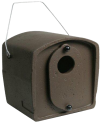![Schwegler Jackdaw Nest Box No.29 Schwegler Jackdaw Nest Box No.29]()
Click to have a closer look
About this product
Specification
Customer reviews
Related products
Recommended products
About this product
The Schwegler Jackdaw Nest Box 29 has been specifically designed for Jackdaws, an endangered species. Jackdaws live in colonies, and therefore several nest boxes should ideally be installed in the same area.
Site: residential buildings, external walls, churches, silos, industrial buildings, etc. Ideally the nest boxes should be spaced approximately 1 to 2 m apart.
Height above ground: min. 6 - 8 m
Specification
Material: Schwegler wood-concrete
Diameter of entrance hole: 8 cm
Nesting chamber: Height 34 x width 30 x depth 30 cm
External dimensions: Height 36 x width 33 x depth 38 cm
Weight: approx. 13.5 kg
Schwegler nest box designs mirror natural holes, with internal dimensions that are similar to the holes made by woodpeckers or caused by decay in old trees.
Schwegler nests will last at least 20-25 years and are readily adopted by birds. This means several decades of breeding success in real life conditions. These nest boxes have been developed in close collaboration with leading ornithologists, nature conservation organisations, Government conservation agencies and forestry experts, and are backed up by decades of experience and knowledge. They are made of a unique wood-concrete material, an entirely natural product consisting of 75% wood and various additives to compensate for climatic changes. This provides insulation against temperature fluctuations, allows air to pass through the walls, and prevents the formation of condensation which often occurs in nest boxes made of plastic, stone or entirely of concrete. This material is also much longer lasting and weather-resistant than wood, and is strong enough to withstand the attention of woodpeckers.
In each nest box the size of the brood chamber, diameter of the entrance hole and many other features have been adapted to the needs and behaviour of the animals themselves. Experiments by bird protection organisations worldwide have demonstrated that the highest density of bird populations (i.e., breeding pairs per hectare) is achieved with Schwegler nest boxes.
Schwegler nest boxes have been officially recognized and approved by the following organisations and numerous others worldwide:
German Federal Biological Centre for Agriculture and Forestry (BBA)
German Nature Protection Association (NABU)
Bavarian Regional Association for the Protection of Birds (LBV)
German Environmental Protection Association (DUH)
Jordsand, Society for the Protection of Seabirds and Nature
EURONATUR/European Cultural Heritage Foundation
LPO, France
Luxemburg Association for the Protection of Birds and Nature
Blue Bird Association of North America
SEO, Spain
LIPU, Italy
Global Nature Fund
Vogelbescherming, Belgium
Customer Reviews
































